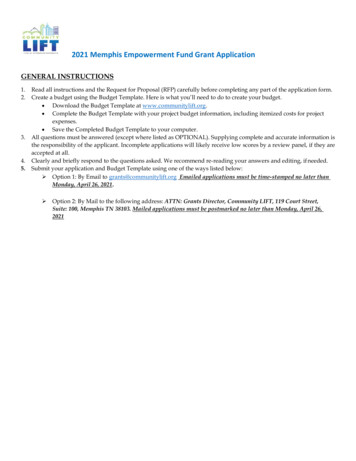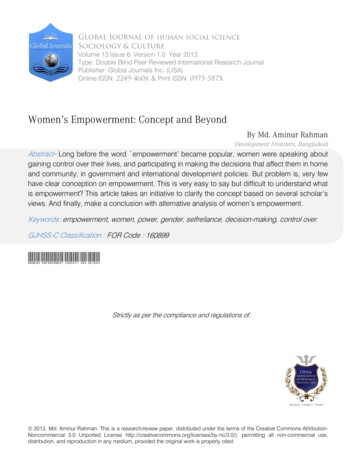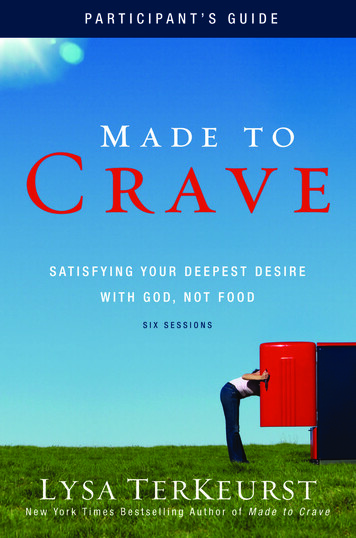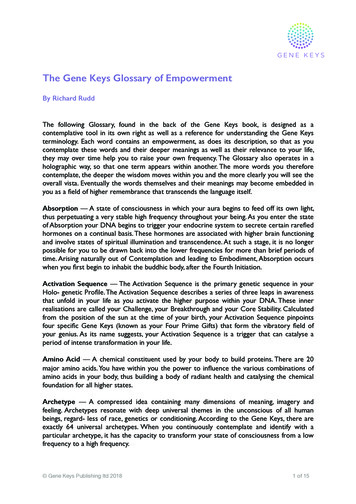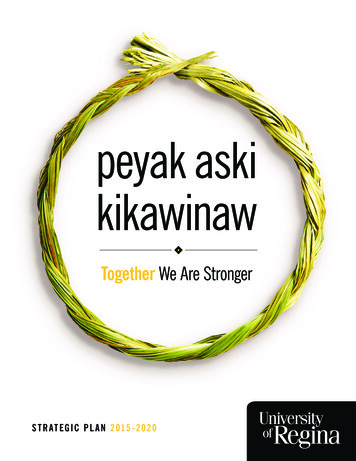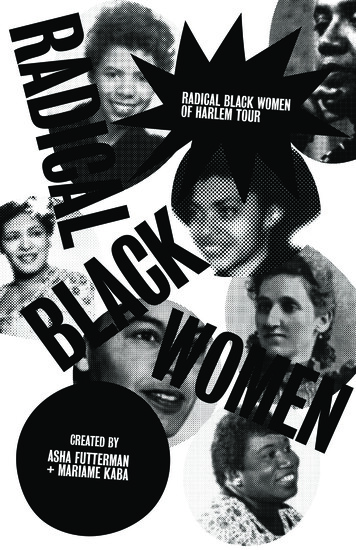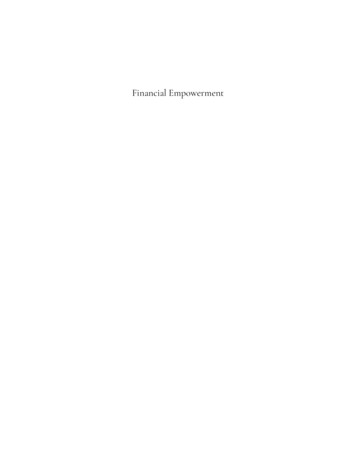
Transcription
Financial Empowerment
Financial EmpowermentPersonal Finance for Indigenous and Non-Indigenous PeopleBETTINA SCHNEIDERSAYLOR ACADEMYUNIVERSITY OF REGINA PRESSREGINA
Financial Empowerment by Bettina Schneider and Saylor Academy is licensed under a Creative CommonsAttribution-NonCommercial-ShareAlike 4.0 International License, except where otherwise noted.Financial Empowerment: Personal Finance for Indigenous and Non-Indigenous People is a derivative work ofthe Personal Finance, v. 1.0 openly licensed textbook adapted by Saylor Academy (2012) under a CreativeCommons Attribution-NonCommerical-ShareAlike 3.0 License without attribution as requested by thework’s original creator and licensee. The textbook can be accessed at: https://saylordotorg.github.io/text personal-finance/index.html.The modifications to the original textbook Personal Finance, v. 1.0 are released under the same license andare described in the section “Modifications made to Personal Finance.”Under the terms of the CC BY-NC-SA 4.0 International License, you are free to copy, redistribute fornon-commercial purposes, modify or adapt this book as long as you provide attribution to BettinaSchneider and Saylor Academy, and distribute any modified work on the same licensing terms.Additionally, if you redistribute this textbook, in whole or in part, in either print or digital format, then youmust retain on every physical and/or electronic page the following attribution:Download Financial Empowerment: Personal Finance for Indigenous and Non-Indigenous People adapted byBettina Schneider from Personal Finance, v. 1.0 by Saylor Academy for free at www.uregina.ca/open-access/open-textbooks.Cover design: John van der Woude, JVDW Designs, is licensed under a CC BY 4.0 International License.Cover photo: Terry Massey, Strictly Social, is licensed under a CC BY 4.0 International License.Video production for the Elder interviews was provided by Terry Massey, Strictly Social. The Elder videosare the copyright of each interviewee and licensed under a CC BY-NC-SA 4.0 International License.For questions regarding this license and publication, please contact: uofrpress@uregina.ca. To learn moreabout University of Regina Press’s Open Textbook Publishing Program, visit www.uofrpress.ca.
ContentsAbout the BookviiPreface to the 2018 EditionxIntroduction1Part I. Learning Basic Skills, Knowledge, and Context1. Personal Financial Planning132. Basic Ideas of Finance393. Financial Statements574. Evaluating Choices: Time, Risk, and Value925. Financial Plans: Budgets1166. Taxes and Tax Planning155Part II. Achieving Your Financial Goals7. Financial Management1858. Consumer Strategies2189. Buying a Home242Part III. Protecting What Is Important to You10. Personal Risk Management: Insurance27211. Personal Risk Management: Retirement and Estate Planning293Part IV. Planning for the Future12. Investing31613. Owning Stocks342
14. Owning Bonds and Investing in Mutual Funds36215. Career Planning392Video Interviews with Elders418Modifications made to Personal Finance430Acknowledgements434About the Author436Open Access Publishing437Library and Archives Canada Cataloguing in Publication438
About the BookFinancial Empowerment is an adaptation of the openly licensed textbook Personal Finance, v. 1.0which was adapted by Saylor Academy under a Creative Commons Attribution-NonCommercialShareAlike 3.0 License without attribution as requested by the work’s original creator or licenseeand is available here: http://www.saylor.org/site/textbooks/.The purpose of this textbook adaptation is to take an accessible, student-focused personalfinance textbook from the United States and make it affordable and relevant for Indigenousand non-Indigenous people in Canada. While many mainstream Canadian personal finance textsprovide excellent content in terms of the mechanics of personal finance, they are expensive andnot always relevant to the values and experiences of students in the classroom. Many mainstream personal finance texts fall short for Indigenous Canadians and non-Indigenous Canadians alike because they do not speak to readers’ varied backgrounds, knowledge systems, andexperiences. This textbook aims to motivate a broad range of students to learn about personalfinance. While it is beyond the scope of this book to address all of the diverse groups thatcomprise the Canadian population, the text does attempt to provide practical, student-focusedinformation that all students can relate to.Everyone needs to be able to see themselves in what they are learning, and this text representsone small effort to make personal finance more relevant to Indigenous students in Canada, andto also teach non-Indigenous students about Indigenous histories, perspectives, and realities. Itis this understanding and knowledge that will contribute to reconciliation in Canada.Another intention of this text is to contribute to real social, political, and economic change,which the Truth and Reconciliation Commission of Canada calls for in order for reconciliation tobe achieved. Increased financial literacy and personal finance knowledge can contribute to thatsocial, political, and economic change.Financial Empowerment is designed for a single-semester introduction to financial planning anddecision-making. It seeks to provide students with the necessary financial literacy and skillsneeded to make sound financial decisions, assess financial risk, and achieve financial success.Given the broad scope and application of financial literacy, this textbook is developed for students taking first- and second-year business and administration courses in a post-secondaryinstitution.The specific goals of this textbook are:About the Book vii
to help students build a solid understanding of personal finance in order to achieve financial literacy and financial success by providing them with the skills and knowledge necessary to navigate short- and long-term financial change; to tailor the content for a Canadian audience by providing Indigenous and non-Indigenousperspectives on personal finance and financial planning using examples and informationfrom the Canadian financial system and economy; to increase accessibility to financial education resources for students and the general public alike, regardless of where they live or study; to customize the content for Indigenous students in Canada and address student needs forpractical and theoretical knowledge on financial decision-making and financial risk assessment; and to connect financial literacy with Indigenous Knowledge and history by threading Indigenous perspectives and interviews with Elders and other community leaders throughout thetextbook.APPROACH AND PEDAGOGYFinancial Empowerment will introduce you to the theory of personal finance through real-lifeexamples of financial decision-making, including videos with Elders. This textbook has beenadapted in order to provide you with the most up-to-date and relevant information. Since thisis an open textbook, there will be annual reviews and updates of the content to ensure that thepredetermined critical learning elements and outcomes are met. Instructors may assign additional readings to each class in order to enrich your learning.Each chapter will begin with a brief overview of the chapter content. Key terms are highlightedin bold.Coloured boxes are used in each chapter to differentiate and highlight important learning features (see the following diagram).viii About the Book
Key Learning FeaturesLearning ObjectivesKey TakeawaysExercisesLearning objectives in the green coloured boxes provide clear directions for each section andprovide structure to your learning. Orange boxes containing key takeaways contain a generaloverview of chapter content at the end of each chapter section. Exercises in the blue boxes atthe end of each chapter section provide additional information, as well as an opportunity forstudents to review and apply what they have learned.Where relevant, a complete list of references is included at the end of chapter sections to clearlydocument and attribute the source material and to assist students in locating resources.Video interviews with Elders provide critical historical information, First Nations perspectiveson personal finance, and wisdom meant to help guide students.Figures, diagrams, and tables provide a plethora of attractive and concise visual learning aids.HYPOTHESISHypothesis (or Hypothes.is) is an open source web annotation tool that students and instructorscan use to highlight and annotate online text, which they can share publicly or privately (forgroup discussion) or use for individual study. Hypothesis encourages deeper engagement withacademic text and other Internet resources.Hypothesis has been enabled for the online format of this textbook. To use this tool, you will firstneed to create a free account with Hypothesis and then follow the step-by-step instructions. Formore information, Hypothesis offers the following Quick Start Guides:1. Quick Start Guide for Students2. Quick Start Guide for TeachersAbout the Book ix
Preface to the 2018 Edition(Adapted from the original)This text has a goal: in addition to providing sources of practical information, it should introduceyou to a way of thinking about your personal financial decisions. This should lead you to thinkingharder and farther about the long-term consequences of your decisions. Many of the more practical aspects of personal finance will change over time, as practices, technologies, intermediaries, customs, and laws change, but a fundamental awareness of how to think well about solvingfinancial questions can always be useful. Some of the more practical ideas may be obviously andimmediately relevant—and some not—but decision-making and research skills are lasting.You may be enrolled in a traditional two- or four-year degree program, or you may just be takingthe course for personal growth. You may be a business major or a family or consumer studies major with some prerequisite knowledge of economics or some level of accounting or mathskills, or you may be filling in an elective and have no such skills. In fact, although such skillscan enhance one’s ability to make personal financial decisions, they are not necessary. Software,downloadable applications, and calculators perform ever more sophisticated functions with evermore approachable interfaces. The emphasis in this text is on understanding the fundamentalrelationships behind the math and being able to use that understanding to make better decisionsabout your personal finances.The idea here is to introduce you to the practical and conceptual framework for making personalfinancial decisions as part of a greater economy of financial participants.STRUCTUREThe text is divided into four parts:Learning Basic Skills, Knowledge, and Context (Chapter 1 “Personal Financial Planning”–Chapter 6 “Taxes and Tax Planning”)Achieving Your Financial Goals (Chapter 7 “Financial Management”–Chapter 9 “Buying a Home”)Protecting What Is Important to You (Chapter 10 “Personal Risk Management: Insurance”–Chapter 11 “Personal Risk Management: Retirement and Estate Planning”)Planning for the Future (Chapter 12 “Investing”–Chapter 15 “Career Planning”)x Preface to the 2018 Edition
This structure is based on the typical life cycle of personal financial decisions, which in turn isbased on the premise that, in a market economy, an individual participates by trading somethingof value: labour or capital. Most of us start with nothing to trade but labour. We hope to sustainour desired lifestyle on the earnings from our labour and to gradually (or quickly) amass capitalthat will then provide additional earnings.PART 1: Learning Basic Skills, Knowledge, and Context(Chapter 1 “Personal Financial Planning”–Chapter 6 “Taxes and Tax Planning”)Chapter 1 “Personal Financial Planning” introduces four major themes of the textbook:1. Financial decisions are individual-specific (Section 1.1 “Individual or ‘Micro’ Factors ThatAffect Financial Thinking”)2. Financial decisions are economic decisions (Section 1.2 “Systemic or ‘Macro’ Factors ThatAffect Financial Thinking”)3. Financial decision-making is a continuous process (Section 1.3 “The Planning Process”)4. Professional advisers work for financial decision-makers (Section 1.4 “Financial PlanningProfessionals”)These themes emphasize the idiosyncratic, systemic, and continuous nature of personal finance,putting decisions within the larger contexts of an entire lifetime and an economy.Chapter 2 “Basic Ideas of Finance” introduces the basic financial and accounting categories ofrevenues, expenses, assets, liabilities, and net worth as tools to understand the relationshipsbetween them as a way, in turn, of organizing financial thinking. It also introduces the conceptsof opportunity costs and sunk costs as implicit but critical considerations in financial thinking.Chapter 3 “Financial Statements” continues with the discussion of organizing financial data tohelp in decision-making and introduces basic analytical tools that can be used to clarify the situation portrayed in financial statements.Chapter 4 “Evaluating Choices: Time, Risk, and Value” introduces the critical relationship of timeand risk to value. It demonstrates the math but focuses on the role that those relationships playin financial thinking, especially in comparing and evaluating choices in making financial decisions.Chapter 5 “Financial Plans: Budgets” demonstrates how organized financial data can be used tocreate a plan, monitor progress, and adjust goals.Preface to the 2018 Edition xi
Chapter 6 “Taxes and Tax Planning” discusses the role of taxation in personal finance and itseffects on earnings and on accumulating wealth. The chapter emphasizes the types, purposes,and impacts of taxes; the organization of resources for information; and the areas of controversythat lead to changes in the tax rules.PART 2: Achieving Your Financial Goals(Chapter 7 “Financial Management”–Chapter 9 “Buying a Home”)Chapter 7 “Financial Management” focuses on financing consumption using current earningsand/or credit, and financing longer-term assets with debt.Chapter 8 “Consumer Strategies” discusses purchasing decisions, starting with recurring consumption, and then goes into detail on the purchase of a car, a more significant and longer-termpurchase both in terms of its use and financing.Chapter 9 “Buying a Home” applies the ideas developed in the previous chapter to what, formost people, will be the major purchase: a home. The chapter discusses its role both as a livingexpense and an investment, as well as the financing and financial consequences of the purchase.PART 3: Protecting What Is Important to You(Chapter 10 “Personal Risk Management: Insurance”–Chapter 11 “Personal Risk Management: Retirement andEstate Planning”)Chapter 10 “Personal Risk Management: Insurance” introduces the idea of incorporating riskmanagement into financial planning. This chapter focuses on planning for the unexpected. Itprogresses from the more obvious risks to property to less obvious risks, such as the possibleinability to earn due to temporary ill health, permanent disability, or death.Chapter 11 “Personal Risk Management: Retirement and Estate Planning” focuses on planning forthe expected: retirement, loss of income from wages, and the subsequent distribution of assetsafter death. Retirement planning discusses ways to develop alternative sources of income fromcapital that can eventually substitute for wages. Estate planning also touches on the considerations and mechanics of distributing accumulated wealth.PART 4: Planning for the Future(Chapter 12 “Investing”–Chapter 15 “Career Planning”)Chapter 12 “Investing” presents basic information about investment instruments and marketsand explains the classic relationships of risk and return developed in modern portfolio theory.xii Preface to the 2018 Edition
Chapter 13 “Owning Stocks” and Chapter 14 “Owning Bonds and Investing in Mutual Funds” lookat investments commonly made by individual investors and their use in (and the risks of) buildingwealth as part of a diverse investment strategy. Chapter 15 “Career Planning” brings the planningprocess full circle with a discussion on how to think about getting started—that is, deciding howto approach the process of selling your labour. The chapter introduces the idea of selling labourto employers in the labour market and explores how to search and apply for a job in light of itsstrategic as well as immediate potential.Preface to the 2018 Edition xiii
IntroductionMy name is Bettina Schneider and I am currently an associate professor and associate vice-president academic at First Nations University of Canada (FNUniv) in Regina, Saskatchewan. I haveworked in the School of Business and Public Administration at FNUniv since 2007. I am nonIndigenous and originally from the United States. I have a PhD in Native American Studies anda master’s in Community Development from the University of California, Davis. My dissertation focused on Indigenous financial institutions in Canada and the United States. Through thisresearch, and my work as a consultant with the First Nations Development Institute and FirstNations Oweesta Corporation in the United States, I was exposed to a number of Indigenousfinancial institutions and the culturally relevant financial literacy curricula they were utilizingand sharing with their communities. In 2013, I began working with the Newo Yotina FriendshipCentre (NYFC) in Regina on the development of culturally relevant financial literacy workshops,as the NYFC had identified a need for such services among its clientele. Thanks to a grant fromthe Urban Aboriginal Knowledge Network, we were able to research and develop such a curriculum for the NYFC. My work with the NYFC was the catalyst for the financial empowermentcourse I later developed at FNUniv and the adaptation of this textbook.PURPOSE OF THIS TEXTBOOKThe purpose of this textbook adaptation is to take an accessible, student-focused personalfinance textbook written for an American audience and make it relevant for Indigenous and nonIndigenous people in Canada. In so doing, it aims to not only help students build their own personal financial capacity, but to prepare them to help others do the same.My greatest goal with this text is to ensure that students do not make the same mistakes thatI and many people before me have made because we did not pursue or have access to financial literacy courses or resources when we were young. Financial literacy education should be arequirement for every student in Canada and throughout the world. It is my sincere hope thatthis Open Access textbook makes the delivery of financial literacy education more accessibleand affordable for all.Financial literacy resources do not always speak to the varied values and experiences of theiraudience. For example, mainstream resources may provide a review of the Canadian tax system,but make no mention of taxation as it relates to First Nations peoples. Furthermore, I believeit is important to understand our own values, histories, and life experiences in order to better1 Introduction
understand our financial decision-making processes. This text attempts to include the perspectives, values, and realities of Indigenous and non-Indigenous people in Canada in order to betterunderstand our relationship to personal finance.Colonization has denied many Indigenous people equal access to money, economic opportunities, financial literacy education, financial institutions, and much more. It was, in fact, the pursuit of money that fueled much of the conquest that colonized Indigenous people in Canada andthroughout the world.During pre-contact times, Indigenous people had a rich economic history that demonstratedstrong personal financial skills. All resources—whether it was buffalo, caribou, elk, or seal—wereutilized fully and nothing was left to waste. How can we apply such principles to personal financetoday? As the Aboriginal Financial Officers Association of BC states, during pre-contact timesIndigenous people were self-sustaining, with strong values that guided how resources and assetswere used, how people traded with one another, and how wealth was shared (AFOA BC, 2011).These skills were passed down and helped many Indigenous people and communities survive thefinancial exclusion and cultural and systemic barriers that came with colonization.This text attempts to share some of the pre- and post-contact histories of Indigenous people, aswell as current financial information that is relevant to both Indigenous people and non-Indigenous people in Canada. It is critical that all Canadians know and understand the histories andrealities of Indigenous people in Canada in order for reconciliation to be possible. I wish thisbook could speak to all of the varied backgrounds, knowledge systems, and experiences of itsCanadian audience. For now, I have done my best with the time allotted to adapt this text tomake it as accessible as possible for Indigenous and non-Indigenous people in Canada.I have chosen to adapt this textbook in order to offer a free text that: is relevant to, and can be accessed by, all Canadians; is student-friendly and provides a solid foundation in personal finance; includes Indigenous and non-Indigenous content in order to enhance the learning experience of all Canadians; and offers a comprehensive range of pedagogical aids.THE NEEDAccording to Jessica Chin (2017), “over half (52 per cent) of Canadians are only 200 away frominsolvency, and 31 per cent don’t make enough to cover their bills, according to a recent pollof 1,500 Canadians by insolvency consultancy MNP. What’s more, 67 per cent aren’t particularlyIntroduction 2
confident about their ability to handle their finances, and when it comes to debt they’ve takenon, 58 per cent wish they could go back and do things differently.” The Canadian Foundationfor Economic Education (CFEE) points out that the number of students who are simultaneouslyattending school and working has been increasing. In fact, about one-half of college or university students will be working while they are attending school (CFEE, 2012). Early interventionsand financial education will help to build financial literacy and self-sufficiency among youth sothat they can make the most of their earnings and avoid the heavy debt and financial challengesthat many Canadians currently experience.In 2014, Jane Rooney, the Government of Canada’s financial literacy leader, met with stakeholdersand held consultations across the country to ensure the development of a national strategy thatmeets the needs of all Canadians. The Financial Consumer Agency of Canada’s (FCAC) resultingnational strategy sets out goals and priorities to help Canadians better manage their financesand make appropriate decisions as their needs and circumstances change. It calls on organizations to join efforts “to help Canadians take action and make financial literacy a life-long journey” (FCAC, 2015, p. 3). I am hopeful that such a strategy, along with an increase in financialliteracy resources and the support of many public-, private-, and non-profit-sector institutions,will help Indigenous and non-Indigenous Canadians meet their needs and achieve the followinggoals outlined in the FCAC’s national strategy: 1) manage money and debt wisely; 2) plan and savefor the future; and 3) prevent and protect against fraud and financial abuse (FCAC, 2015, p. 5).According to Prosper Canada, over 1.4 million Indigenous people live in urban, rural, and remotecommunities across Canada. These 1.4 million people are comprised of “three distinct self-identified Aboriginal groups with diverse cultures, languages, and spiritual beliefs: First Nations (over60 per cent), Métis (32 per cent), and Inuit (just over 4 per cent)” (Prosper Canada, 2017). Overall, the Indigenous population is young and it is the fastest growing segment of Canada’s population. A large proportion of the Indigenous population is in the early phases of financial life(e.g., finding employment, pursuing education, buying a car and a first home) and will thus benefit from early interventions and financial education that address the early life stage (ProsperCanada, 2017). Furthermore, Indigenous entrepreneurship is also growing, “increasing 38 percent between 2001 and 2006, a rate five times higher than that of Canadians overall” (ProsperCanada, 2017). A strong foundation in financial literacy is critical to the success of Indigenousentrepreneurs. Being financially literate helps to support the overall sustainability of a businessand a healthy bottom line, one with which entrepreneurs can make confident financial decisionsthat will benefit them and their businesses.3 Introduction
RECONCILIATION AND FINANCIAL LITERACYThe Truth and Reconciliation Commission of Canada (TRC) has stated that apologies and reparations are not enough; in order for reconciliation to be achieved, real social, political, and economic change is needed (TRC, 2015). The 94 Calls to Action issued by the TRC are meant toguide this change in Canada. One of the Calls to Action is to develop culturally appropriate curricula. Culture, history, and world views are key components of culturally appropriate educational resources (Weaver, 1999). As Dominque Collins, author of Aboriginal Financial Literacyin Canada, has demonstrated, culturally relevant training has shown to be effective (Collins,2011). In order to incorporate Indigenous world views and perspectives into this textbook, eightelders from FNUniv were interviewed between June 2017 and July 2018. Their perspectives, alongwith the perspectives and world views of other Indigenous people and organizations, have beenincorporated into different sections of this textbook wherever possible.The Aboriginal Financial Officers Association of British Columbia (AFOA BC), First Nations Development Institute (FNDI), and First Nations Oweesta Corporation (FNOC) have been at theforefront of the development of culturally relevant financial literacy curriculum in Indigenouscommunities in Canada and the United States. Both FNDI and FNOC have written extensivelyabout the long history of traditional resource management in Indigenous communities andhave compared it to financial management today. As stated in the Building Native Communitiesfinancial literacy curriculum, produced by FNDI and FNOC, “Traditional resource managementteaches us that our actions today affect the resources that we will have available in the future”(FNDI and FNOC, 2015, p. 74).As Oweesta and FNDI point out, Indigenous communities have traditionally demonstratedtremendous skill in managing resources to support the needs of their communities on an ongoing basis, as the following statement makes clear: “For years, our people have understoodand practiced the present-day concepts of budgeting and savings. We managed our resourcesthrough conservation so that they lasted throughout the year by saving additional supplies forfuture use. Our people also saved for the purpose of acquiring goods that we could not produceourselves. By producing more than the community needed, we had goods to trade” (FNDI andFNOC, 2015, p. 1).However, the effects of colonization have denied many Indigenous people access to this economic history (Elder Kewistep, Video 2). By relating the past to the present, this textbookattempts to honour that rich history; ideally, this will make the information in this textbookmore accessible for Indigenous students and build cultural awareness among non-Indigenousstudents as well.Introduction 4
For many, saving money can be perceived as hoarding or buying into a consumer culture thatdoes not reflect their values. Elder and FNUniv Professor Emeritus, Willie Ermine, shared, “Wedon’t have a culture of saving money. . . . It’s almost a sin in our communities . . . to be one that[hoards money]” (personal communication, June 10, 2017) (Video 3).Elder Ermine discusses the concept of the giveaway and the importance of giving “somethingthat you treasure to get something that you need; it’s the same system as money. I can give youmoney and you give me what I need. [The giveaway] has been there thousands of years . . . we doceremonies that giveaway in return for whatever it is that I need. The more we do that, the morethis cycle continues. The more you give, the more you get” (personal communication, June 10,2017) (Elder Ermine, Video 2). Elder Ermine offers these ideas as a counter-narrative to discussions of Indigenous people and financial management. While savings are important in terms ofhow they help you to support your loved ones and community, giving is important for other reasons, and people are often judged more so for what they give rather than what they have (ElderErmine, Video 1B).Another form of giveaway in the Pacific Northwest is the Potlach, a Chinook word for “giveaway” or “gift,” which is a ceremony meant to give thanks and redistribute wealth. AFOA BCstates that “the potlach system is an example of financial literacy in a pre-contact context. Weshowed our wealth by giving and sharing with others. Wealth was managed through potlach andit worked—we did not have the poverty and dependency we have today. Our people had clotheson their backs and food in their bellies. In 1884, the potlach system was banned and so were ourteachings about wealth management. . . . We need to look for new ways to learn about moneyand how to manage it” (AFOA BC, 2011, p. 6).Today, there are so many examples of Indigenous people, communities, and organizations sharing their financial success with others (Elder Reynolds, Video 4; Elder Cochrane, Video 2). Whensavings can be linked to giving, supporting, and planning for the future of our loved ones andcommunities,
Financial Empowerment: Personal Finance for Indigenous and Non-Indigenous People is a derivative work of thePersonal Finance, v. 1.0 openly licensed textbook adapted by Saylor Academy (2012) under a Creative Commons Attribution-NonCommerical-ShareAlike 3.0 License without attribution
